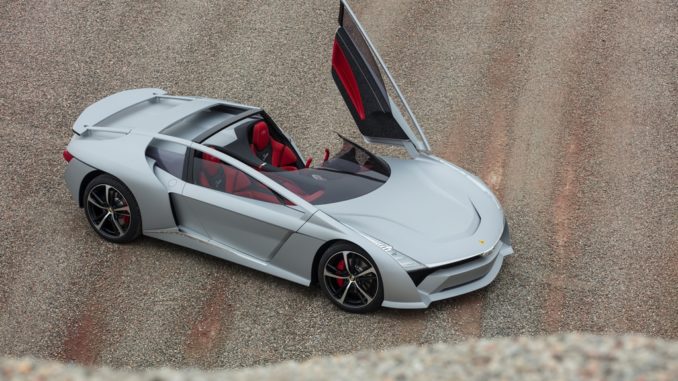
The electric four wheel drive Barchetta Bandini Dora is powered by two electric motors with a total of 400 kW on its two axles, space frame aluminium chassis and carbon fibre bodywork.
A hedonistic, open, two-seater car, designed for outdoor leisure, a quintessential of sports cars manufactured by Bandini in the 50’s.
Today it is difficult to conceive a Barchetta without considering the evolution there has been in the car concerning safety – says Giugiaro – inspired by the Halo of Formula 1, we thought about creating a car that had a clean windshield as it used to be used with no reinforcements, thus being as linear and light as possible. To solve this need, I thought of an out-an-out superstructure that would integrate into the style with an accentuated structural and protective function for both the driver and passenger.
Modern style, long but unique in its shape, given the characteristic of the protection/pillars, very large headlights that define a very long bonnet, a roll bar that becomes a spoiler, inserting itself into the sides with a play on sharp and smooth shapes, according to aerodynamic needs.
In the Giugiaros’ opinion, it is the Barchetta of 2020.
Exterior
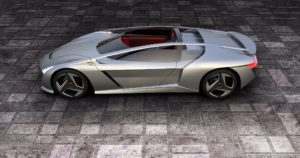 The lateral line is characterised by a structural pillar that starts from the front mudguard, sloping the shape as if it were a coupé tangential to the central front axle.
The lateral line is characterised by a structural pillar that starts from the front mudguard, sloping the shape as if it were a coupé tangential to the central front axle.
The longitudinal pillar has a structural function and ends in the rear part as a support to the bonnet opening connected to the spoiler that adjusts automatically according to aerodynamic needs.
The wraparound windshield passes under the pillars and protects the passenger compartment from return air flows.
The feature is exactly this line that slopes as if it were a coupè, therefore a structure that harmoniously links the front with the rear with the uniqueness of this windshield that passes under this structure – says Giugiaro.
Overall, an intertwining of lines can be noted that close both in the front and rear, optically creating a criss-cross double movement.
The front headlights are housed on the bonnet on the outside of the side profile, which highlight the mudguard line, to then ascend vertically on the structure with a continuous and linear style, optically “embracing” the entire front.
This creates its very distinctive identity, the lightning bolt shaped vertical headlights house the DRLs positioned at the ends of the line that also serve as indicator lights that go up to the windshield.
The front has two air intakes that go down the sides; the bonnet is characterised by an air outtake and two reliefs of the wheel passages that compose the sculpture of the bonnet.
The overhangs are short and tapered, highlighting the wheel arches that are tangential to the tyres.
The horizontal “lightning bolt” sign is also at the rear in the lights in keeping with the style of the front lights.
The rear air outtakes allow total outflow from both the wheel arches and the rest of the chassis.
The air intake in front of the wheel, which protrudes from the side, develops in the upper part becoming a spoiler/wing, which tightly encloses the side panel in its rear development.
The configuration of the car is dedicated to the sportsmanship and individuality of the driver compared to the passenger as they don’t even have optical contact.
Interior
Access inside is through the fully automated scissor doors.
The interior is characterised by a structural element that divides and delimits the area of the driver from the passenger, a structural bridge, a raised through tunnel.
The driving position is adjusted by moving the steering column and pedal set whose controls are on the central tunnel.
The cloche-type steering wheel has a touchscreen monitor giving the driver the opportunity to intervene on all the functions of the car from navigation to infotainment to vehicle controls.
The instrumentation above the steering column gives the information and the visualization of the two side cameras.
It is a completely “switchless” interior.
The innovative carbon and leather seats are fixed but the height and backrest can be adjusted.
A continuous beam of light underlines the design of the dashboard giving a unique internal lighting.
Great use of fine materials such as leather and technology such as carbon fibre are used to lighten and give overall sportiness to the car.
Bandini
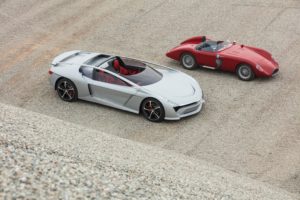 The history of Bandini cars was hitherto indissolubly linked to the exploits of Ilario Bandini; an artisan from Romagna animated by his passion for cars, for racing and that all-Italian creative angst aimed at the incessant product updating and improvement. Maniacal and “fatherly” care that transformed each of the 75 cars produced into treasure chests full of anecdotes crossing the history and technical evolution of the two-seater racing cars, from 1946 until 1992.
The history of Bandini cars was hitherto indissolubly linked to the exploits of Ilario Bandini; an artisan from Romagna animated by his passion for cars, for racing and that all-Italian creative angst aimed at the incessant product updating and improvement. Maniacal and “fatherly” care that transformed each of the 75 cars produced into treasure chests full of anecdotes crossing the history and technical evolution of the two-seater racing cars, from 1946 until 1992.
A Bandini 750 sport international Barchetta from the Mille Miglia Museum will be exhibited at the GFG Style Stand, a car that competed in the last edition of the most famous road races in1957.
Today, Bandini Automobili s.r.l., thanks to Michele, the founder’s great grandson, is a reality that after a long period dedicated to financial, design and industrial reorganisation, is back on the scene of sports car production in limited series, which know how to whet your appetite for gripping a wheel.
Technical Data Bandini Dora
| Brand | BANDINI |
| Model | DORA |
| Type | Barchetta |
| Seats | 2 |
| Power | 400 Kw |
| Wheel Torque | 680 Nm |
| Drive Wheel | AWD |
| Accelleration | 0-100 km/h 3,3 sec. |
| Top Speed | 250 km/h limited |
| All Electric Range | Over 450 km |
| Battery | Capacity 90 Kwh |
| Chassis | Aluminum Space Frame |
| Body | Carbon Fiber |
| Length | 4800 mm |
| Width | 2000 mm |
| Height | 1150 |
| Wheelbase | 3000 |
| Tyres | 245/40 R21 |
Below you can see the videos
Source: GFG Style

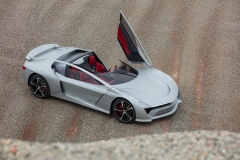
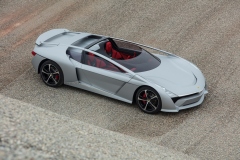
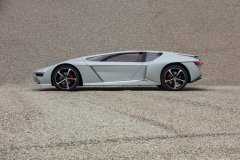
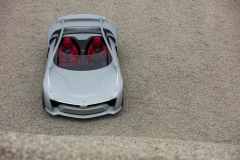

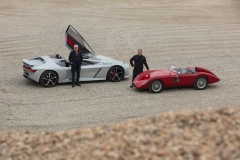
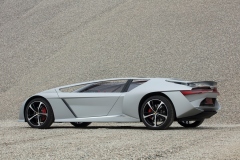

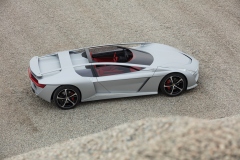
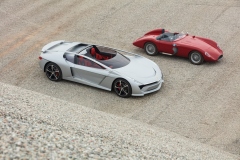
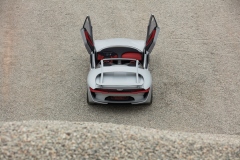
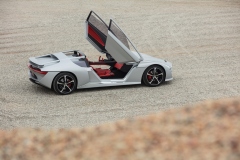
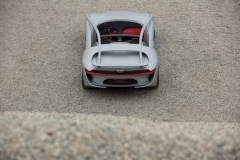
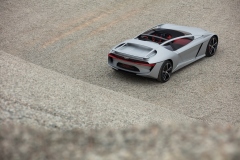
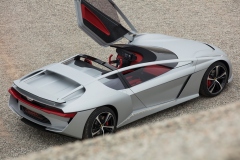

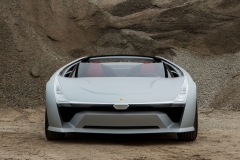






Be the first to comment